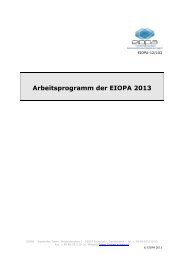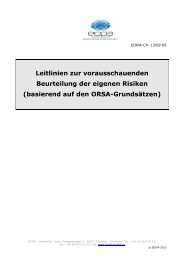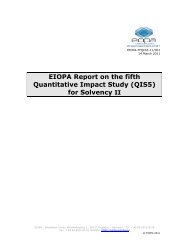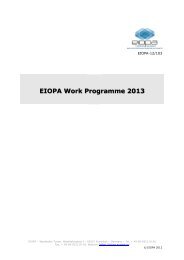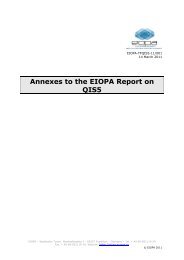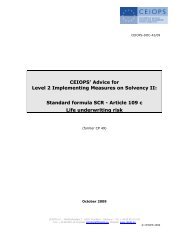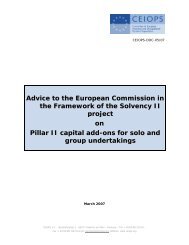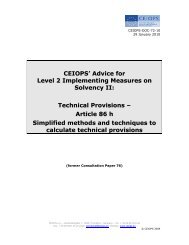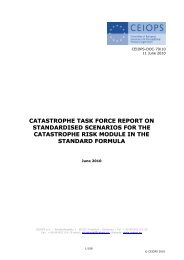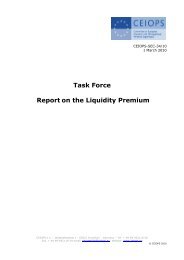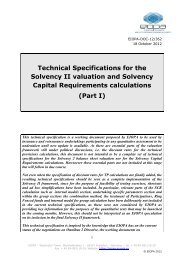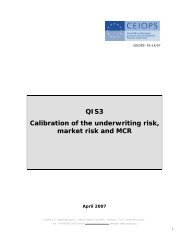Answers to the European Commission on the ... - Eiopa - Europa
Answers to the European Commission on the ... - Eiopa - Europa
Answers to the European Commission on the ... - Eiopa - Europa
You also want an ePaper? Increase the reach of your titles
YUMPU automatically turns print PDFs into web optimized ePapers that Google loves.
C<strong>on</strong>clusi<strong>on</strong><br />
In general, <str<strong>on</strong>g>the</str<strong>on</strong>g>re was no main single cause of <str<strong>on</strong>g>the</str<strong>on</strong>g> actual failures, in c<strong>on</strong>trast <str<strong>on</strong>g>to</str<strong>on</strong>g><br />
<str<strong>on</strong>g>the</str<strong>on</strong>g> findings of <str<strong>on</strong>g>the</str<strong>on</strong>g> Sharma report for failures 1996-2001, where it was c<strong>on</strong>cluded<br />
that management represented <str<strong>on</strong>g>the</str<strong>on</strong>g> main cause. Referring <str<strong>on</strong>g>to</str<strong>on</strong>g> life insurance<br />
companies, <str<strong>on</strong>g>the</str<strong>on</strong>g> difficulty that was menti<strong>on</strong>ed most often over recent years was<br />
<str<strong>on</strong>g>the</str<strong>on</strong>g> depreciati<strong>on</strong> of investments due <str<strong>on</strong>g>to</str<strong>on</strong>g> <str<strong>on</strong>g>the</str<strong>on</strong>g> downturn <strong>on</strong> <str<strong>on</strong>g>the</str<strong>on</strong>g> capital markets that<br />
spanned <str<strong>on</strong>g>the</str<strong>on</strong>g> period of <str<strong>on</strong>g>the</str<strong>on</strong>g> survey.<br />
The survey indicates that no single cause led <str<strong>on</strong>g>to</str<strong>on</strong>g> bankruptcy or o<str<strong>on</strong>g>the</str<strong>on</strong>g>r failures, but<br />
instead identified a number of different risk categories. In this c<strong>on</strong>text, it is<br />
obvious that <strong>on</strong>ly an enterprise-wide risk management policy that takes all <str<strong>on</strong>g>the</str<strong>on</strong>g><br />
different risks in<str<strong>on</strong>g>to</str<strong>on</strong>g> account represents appropriate coverage. Thus, <str<strong>on</strong>g>the</str<strong>on</strong>g> emphasis<br />
which CEIOPS is currently placing <strong>on</strong> an enterprise-wide approach within<br />
Solvency II is very important.<br />
With regard <str<strong>on</strong>g>to</str<strong>on</strong>g> <str<strong>on</strong>g>the</str<strong>on</strong>g> c<strong>on</strong>crete levels of <str<strong>on</strong>g>the</str<strong>on</strong>g> future solvency system, <str<strong>on</strong>g>the</str<strong>on</strong>g> survey<br />
identified that <str<strong>on</strong>g>the</str<strong>on</strong>g> 150% of current solvency ratio represents a critical level, and<br />
that breaching <str<strong>on</strong>g>the</str<strong>on</strong>g> 150% could serve as a solvency c<strong>on</strong>trol level triggering<br />
intensified supervisi<strong>on</strong>, since most failures occur when entities breach <str<strong>on</strong>g>the</str<strong>on</strong>g> 150 %<br />
of solvency ratio. With regard <str<strong>on</strong>g>to</str<strong>on</strong>g> <str<strong>on</strong>g>the</str<strong>on</strong>g> MCR, CEIOPS proposes that a percentage<br />
such as <str<strong>on</strong>g>the</str<strong>on</strong>g> 150% solvency ratio should trigger extraordinary supervisory<br />
interventi<strong>on</strong>. It may also be necessary <str<strong>on</strong>g>to</str<strong>on</strong>g> take <str<strong>on</strong>g>the</str<strong>on</strong>g> relati<strong>on</strong>ship between MCR and<br />
SCR in<str<strong>on</strong>g>to</str<strong>on</strong>g> account, since 150% of <str<strong>on</strong>g>the</str<strong>on</strong>g> MCR could already be above <str<strong>on</strong>g>the</str<strong>on</strong>g> SCR. The<br />
actuarial percentage would need <str<strong>on</strong>g>to</str<strong>on</strong>g> be assessed <str<strong>on</strong>g>to</str<strong>on</strong>g> take in<str<strong>on</strong>g>to</str<strong>on</strong>g> c<strong>on</strong>siderati<strong>on</strong><br />
changes in <str<strong>on</strong>g>the</str<strong>on</strong>g> determinati<strong>on</strong> of asset values, liability values (including technical<br />
provisi<strong>on</strong>s0 and <str<strong>on</strong>g>the</str<strong>on</strong>g> impact of <str<strong>on</strong>g>the</str<strong>on</strong>g>se changes <strong>on</strong> <str<strong>on</strong>g>the</str<strong>on</strong>g> MCR.<br />
With regard <str<strong>on</strong>g>to</str<strong>on</strong>g> <str<strong>on</strong>g>the</str<strong>on</strong>g> SCR, <str<strong>on</strong>g>the</str<strong>on</strong>g> survey does not provide any answers <strong>on</strong> new<br />
solvency c<strong>on</strong>trol levels, since <str<strong>on</strong>g>the</str<strong>on</strong>g> existing solvency ratio is c<strong>on</strong>sidered <str<strong>on</strong>g>to</str<strong>on</strong>g> be <str<strong>on</strong>g>to</str<strong>on</strong>g>o<br />
different from <str<strong>on</strong>g>the</str<strong>on</strong>g> SCR (<str<strong>on</strong>g>to</str<strong>on</strong>g>o risk-insensitive).<br />
267



